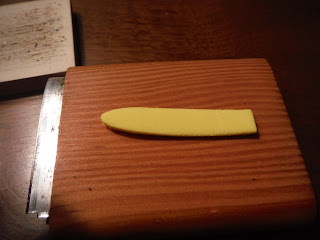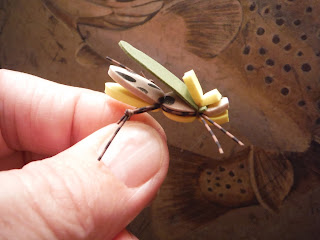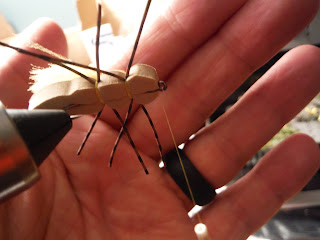I found some Rainy's Gorilla Bodies on sale for 88 cents. Never having used them, I figured it would diversify the fly box a bit more and keep me entertained at the vise. If you don't have any foam cutters or are not looking to spend a few bucks on them, pick up a few of these at the fly shop. I think they are reglarly priced at just a few bucks. Good investment for a fun time on the water. Expirementing with hopper patterns, I figure just about any well tyed hopper pattern will land fish. After all, there are soooo many hopper patterns at the store, in catalogs, etc.
1. (Using a 4 segment Gorilla body) With razor blade, or scissors, cut slit in foam from about 2 mm past last segment through head - 1 mm deep
2. Wrap thread on hook
(Gamakatsu b10s size 6, daiichi, Mustad or whatever you think would work for you) and set bobbin at middle of body. Make about 10 wraps (depending on thread size).
3. Add a leg (1.5" in length) on front side and make several wraps of thread and then do the same on the far side.
4. Tie in about 1.5" to 2" of antron yarn. Fold yarn back over abdomen and then make several wraps of yarn around segment. Trim to match length of abdoment. You may have to use a brush to even out the wing.
5. Tie in foam indicator (cut it several millimeters narrow of the body and then cut a little point into the front of the indicator and a longer point like an isosceles triangle on the top of the indicator which will be placed over the wing). Sometimes, I trim the foam after I finish the body.
6. Wrap thread up to front segment. Make 6 wraps of thread. Add legs. Place front of indicator down and make several more wraps of thread.
7. Make several half-hitches - I make at least 3 - around front segment (between legs).
If you are not comfortable make half-hitches around the body, then wind thread to front and do some whip finishes or wahtever you need to complete your tye.
8. Apply adhesive down hook shank (slit) and at front and rear wraps of thread.
DO NOT get adhesive on the legs, it makes them shrink up or harden or "twonky".
If you desire, add eyes.
One key to landing fish is a proper hook. I've been using Daiichi hooks but have since moved to a Gamakatsu b10s - just the right gap for smallmouth bass and very sharp. While I have caught Smallmouth Bass on 2X streamer hooks, wet nymph or dry fly hooks, I was frustrated on several outings when I just couldn't set the hook - maybe it was me but I think a more exposed gap could essentially land more Smallies - or other species.
Let me know if you have any questions.
Tight lines.























































